Συνέντευξη με τον Κώστα Λαμπρίδη
DS.WRITER:
Sophia Throuvala
Στην πρώτη του ατομική έκθεση στην γκαλερί Carpenters Workshop στο Παρίσι, παρουσίασε μια σειρά εννέα έργων υπό τον τίτλο “Elemental Flods”, τα οποία αποτελούν δημιουργικά επεξεργασμένες αναφορές σε ιστορικές καλλιτεχνικές φόρμες, ενωμένες σε κάτι σύγχρονο. Το γνωστότερο έργο του Κώστα Λαμπρίδη είναι το Elemental Cabinet, κεντρικό έκθεμα στο Παρίσι, το οποίο αποτελεί “επανεκτέλεση” του Badminton Cabinet του 18ου αιώνα και όχι μόνο. Συναντηθήκαμε στο εργαστήριό του και συζητήσαμε για τα έπιπλα που έχει ήδη δημιουργήσει αλλά και για τα έπιπλα που οραματίζεται, για τις έννοιες που τον απασχολούν, όπως το τι σημαίνει έπιπλο και χρόνος, ενώ επίσης κάναμε και μια ευρύτερη κουβέντα περί υλικών, ιστορίας, δημιουργικής φθοράς και design.
-Πώς ορίζεις τη σχέση σου με την υλικότητα και τις υφές; Με ποιο κριτήριο επιλέγεις; Θεωρείς ότι η επιλογή των παραμέτρων αυτών προδιαγράφει το υφολογικό αποτέλεσμα; Ποια είναι η διαδικασία που ακολουθείς;
Κ.Λ: Αν μπορώ να πω κάτι με σιγουριά, αυτό είναι ότι κάνω αντικείμενα. Δηλαδή, αν έπρεπε να το ορίσω κάπως, θα απέφευγα να χρησιμοποιήσω έναν προσδιορισμό ως προς το τι είμαι εγώ, αλλά θα προτιμούσα περισσότερο να χαρακτηρίσω αυτό που κάνω. Οπότε, μάλλον η σωστή λέξη είναι: “αντικείμενα”. Αντικείμενα, εξ ορισμού, σημαίνει υλικότητα και φυσική υπόσταση. Δεν έχει να κάνει με τις υφές -κατά τη γνώμη μου-, αλλά με το υλικό από το οποίο ξεκινάω. Ξεκινάω, δηλαδή, βλέποντας μια πέτρα στη θάλασσα. Η υφή αφορά τη διαδικασία της επεξεργασίας σε μια δεύτερη φάση, και το πώς κατευθύνεις το υλικό σε κάτι άλλο. Αλλά και πριν από αυτό, θέλω να νιώθω τον κόσμο γύρω μου σαν εν δυνάμει πρώτη ύλη. Χωρίς περιορισμούς. Είτε είναι κάτι φυσικό, μια πέτρα δίπλα στη θάλασσα, είτε μια σπασμένη συρταριέρα ακουμπισμένη σε έναν κάδο στην Κυψέλη, ας πούμε.
-Θα λέγαμε λοιπόν ότι, προκειμένου να συγκεντρώσεις τα υλικά που σου είναι απαραίτητα προκειμένου να δημιουργήσεις κάτι το συλλεκτικό, κάνεις εσύ πρώτος μια συλλογή;
Κ.Λ: Ναι, αλλά αυτή δεν είναι κάποια δεδομένη διαδικασία που ακολουθώ. Δεν μαζεύω πράγματα και μετά από αυτά συνθέτω κάτι, δεν χαρακτηρίζει δηλαδή τη “συλλογή” μια αυστηρή μορφή αρχής και τέλους. Στην πορεία της διαδικασίας, φτιάχνονται και πράγματα για να γεμίσουν κάποιο κενό. Οπότε, εκεί υπάρχει μια διαδικασία άλλη, η οποία είναι πιο κοντά στη σχεδιαστική διαδικασία και πιο μακριά από τη συνθετική. Με ενδιαφέρουν όμως και τα δύο εξίσου, δηλαδή το να γεμίσω ένα κενό που προκύπτει από τη σύνθεση είναι σημαντικό. Δεν θεωρώ ότι κάποιο από τα δύο “στάδια” έχει περισσότερο ή λιγότερο νόημα ή αξία. Και το κενό είναι ιδιαίτερα σημαντικό, είτε το συμπληρώνεις και κάνεις κάτι πχ λειτουργικό, είτε επιλέγεις να το αφήσεις ως έχει, δηλαδή του επιτρέπεις να υπάρξει ως κενό. Γενικότερα, πυρήνας αυτού που κάνω είναι η αναζήτηση, και μέσα στην αναζήτηση με ενδιαφέρει τόσο να παρέμβω και να κατευθύνω τα πράγματα προς τα κάπου, όσο και το να αποδεχτώ κάτι και να το αφήσω ως έχει.
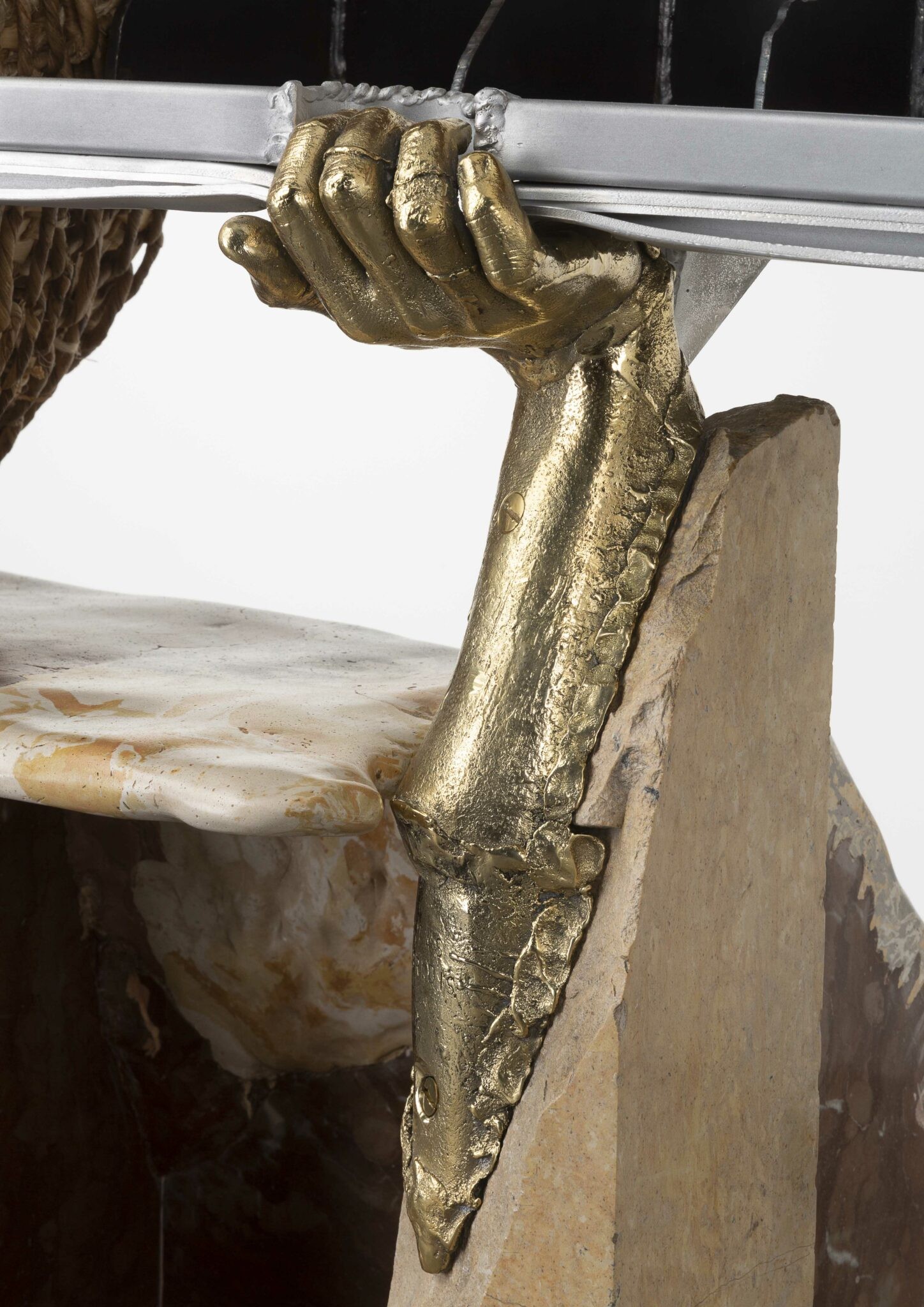
LAMBRIDIS, Its-Not-Enough, https://kostaslambridis.com
-Άρα, η διαδικασία που ακολουθείς δεν είναι κανόνας ή μέθοδος, δεν είναι συγκεκριμένη. Σωστά;
Κ.Λ: Ναι, δεν είναι συγκεκριμένη. Θα μου άρεσε να πω ότι η διαδικασία εξελίσσεται οργανικά, αλλά η αλήθεια είναι πως δεν είναι πάντα έτσι. Κάπου στην πορεία δημιουργείται και η ανάγκη για μια δομή, μαλλον ξένη στη διαδικασία. Επίσης, μέσα στην πορεία, το έργο πρέπει να “σπάσει” σε διάφορα tasks τα οποία μπορούν να εκτελέσουν άλλοι, κάπου προκύπτει η αμφιβολία για αυτό που κάνεις, και εκεί έρχονται νέες επιλογές, σωστές και λάθος. Και κάπως έτσι, πολλές φορές, παύει να είναι κάτι το οργανικό, και, ακολουθώντας ίσως και τα λάθη ακόμα, μπορεί να πας σε κάτι άλλο, προς κάποια κατεύθυνση που είναι περισσότερο δική σου ανάγκη, ή προς κάποια αναφορά σε κάτι δεδομένο και λειτουργικό, ή ακόμα χειρότερα προς κάτι άλλο που δεν έχει να κάνει καν με εσένα. Και όλα είναι μέρος της διαδικασίας. Το θέμα είναι να είσαι ανοιχτός και να μπορείς να τα βλέπεις. Να χάνεις τον δρόμο σου, αλλά να τον ξαναβρίσκεις.
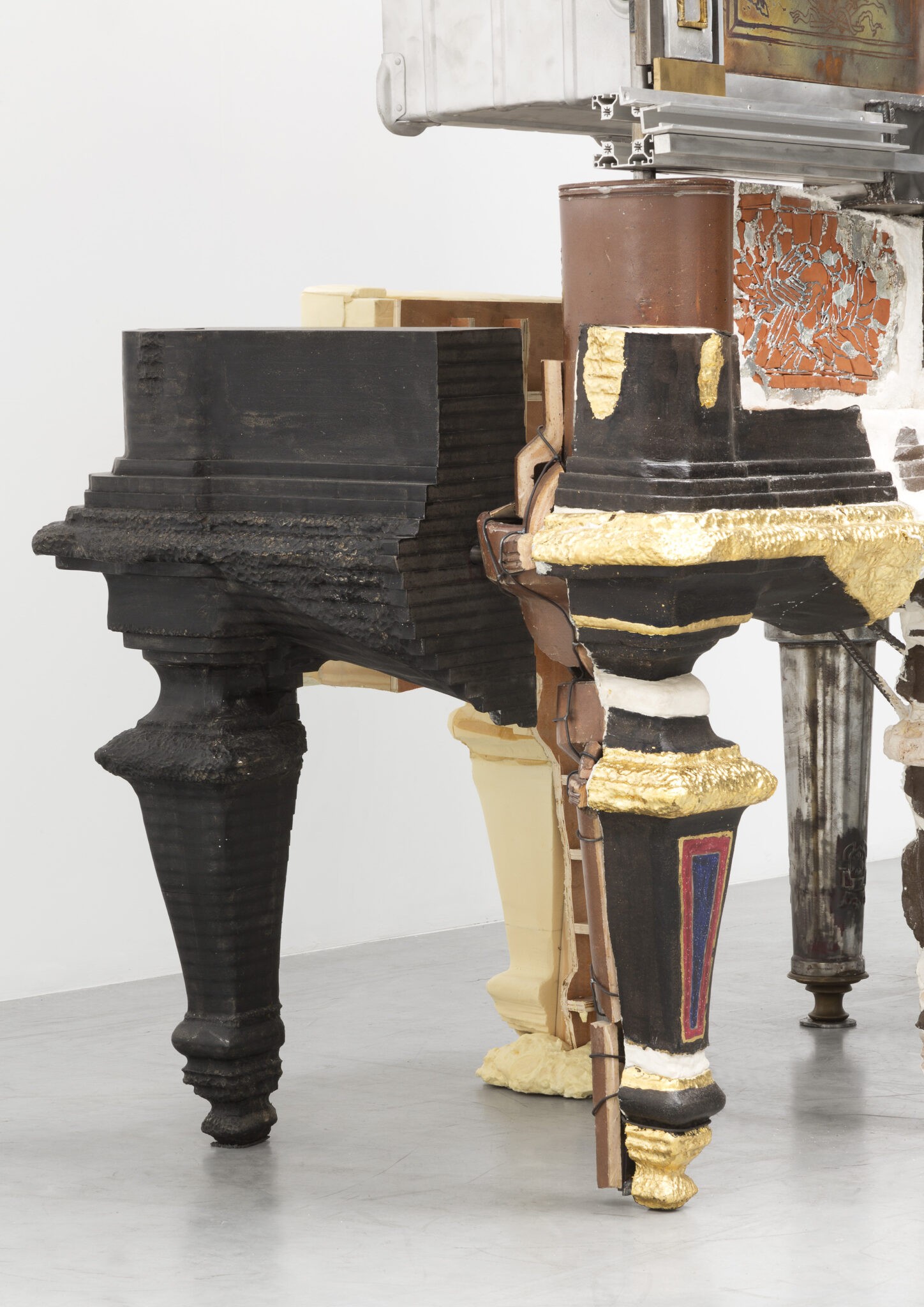
LAMBRIDIS_Elemental_Cabinet_ https://kostaslambridis.com
-Αναπαράγεις τις κλασικές φόρμες ή τις επεξεργάζεσαι και τις αποδίδεις με μια κριτική ματιά; Για παράδειγμα, οι αναφορές στο Μπαρόκ έχουν περισσότερο σχέση με έναν μαξιμαλισμό της ιστορικής φόρμας, ή θεωρείς πως τα υλικά σου βοηθούν στην απλούστευση;
Κ.Λ: Νιώθω πως είμαι στην πολύ αρχή ακόμα για να μπορώ να μιλήσω για τη δουλειά μου με έναν τρόπο -ας πουμε.-συνολικό. Νομίζω, δηλαδή, ότι αυτό που κάνω τώρα έχει ως αφετηρία τη διπλωματική μου στην Ολλανδία. Οπότε θα έλεγα ότι εκεί άνοιξα κάτι, έναν χώρο αν θες, τον οποίο ακόμα και τώρα τον εξερευνώ. Με ενδιαφέρει λοιπόν το έπιπλο, όχι μόνο ως λειτουργικό αντικείμενο στο σπίτι, αλλά και ως ιστορικό αντικείμενο. Οι μαξιμαλιστικές φόρμες και τα πολύτιμα υλικά του Μπαρόκ με γοητεύουν και με απωθούν ταυτόχρονα. Νιώθω όμως ότι έχει κάτι το πραγματικά σπουδαίο που το αφήσαμε πίσω μας, και δεν έχει να κάνει με το πολύτιμο, το αριστοκρατικό, το θρησκευτικό κλπ. Έχει να κάνει με τη σχέση του ανθρώπου με την ύλη. Με ενδιαφέρει δηλαδή η διαδικασία κατασκευής και δημιουργίας αυτών των αντικειμένων, τόσο ιστορικά όσο και στο σήμερα.
-Εσύ ιεραρχείς κάπως τις επιλογές σου, τις αναφορές σου πάνω στην ενιαία δομή του έργου; Για παράδειγμα, ένα πόδι-αναφορά στον Jean Dubuffet (1901–1985), έχει συγκεκριμένο λόγο που έχει τη θέση που έχει, σε σχέση με ένα μπαρόκ μικρόγλυπτο;
Κ.Λ: Στην αρχή το έκανα πολύ αυτό, με έναν τρόπο σχεδόν εμμονικό. Δηλαδή, η κάθε λεπτομέρεια είχε ξεκάθαρο λόγο να είναι όπως είναι και εκεί που είναι, και σε συσχέτιση με ό,τι άλλο συμβαίνει πάνω στο έργο. Πλέον προσπαθώ να το μετριάσω αυτό, και να δώσω χώρο και στο τυχαίο και στο παράλογο. Δεν μου είναι εύκολο να το κάνω αυτό, είναι κόντρα στη φύση μου, αλλά πιστεύω ότι, όσο πιο ετερόκλιτα είναι τα έργα, και όσο μεγαλύτερα άλματα γίνονται στις ιστορικές περιόδους, και όσο μεγαλύτερη απόσταση έχουν αυτά τα οποία συμβολίζουν, τόσο καλύτερη είναι η συμπαράθεσή τους. Συνέχεια προσπαθώ να συστήνω το χάος μέσα στη δομή. Μου αρέσει να σπρώχνω τα πράγματα προς την εντροπία. Βέβαια, όταν η εντροπία γίνεται έντονη και η δομή τείνει προς το ανοίκειο, προσπαθώ να επαναφέρω τη δομή και το γνώριμο. Θέλω κάτι χαοτικό αλλά και αυστηρά δομημένο, συνεπές. Η ολότητα για εμένα είναι μια πολύ σημαντική έννοια.
-Σχετικά με το ολόκληρο και την κυκλικότητα που ανέφερες, πιστεύεις ότι η δουλειά σου είναι πολιτισμικά συμπεριληπτική ή οι αναφορές σου εξαντλούνται στη δυτική κυρίως παράδοση; Κατά πόσο σε ενδιαφέρει να εξερευνήσεις και να εντάξεις στοιχεία τέτοια στη δομή ή στη διαδικασία; Οι αναφορές που πιθανότατα ενυπάρχουν στο έργο σου είναι περισσότερο διαμεσολαβημένες από αναφορές σε έργα δυτικά, που τα ίδια εμπνεύστηκαν από άλλους πολιτισμούς, ή εσύ επιδιώκεις μια ώσμωση;
Κ.Λ: Θέλω να πιστεύω ότι αυτός δεν είναι ένας δικός μου περιορισμός. Ή τουλάχιστον σε ένα θεωρητικό υπόβαθρο, με ενδιαφέρει πολύ το πάντρεμα πραγμάτων που προέρχονται από διαφορετικούς πολιτισμούς, διαφορετικές ιστορικές περιόδους, γιατί πάντα οι πολιτισμοί συνδιαλέγονταν με τον ένα ή τον άλλο τρόπο, ακόμα και αν αναπτύσσονταν ετεροχρονισμένα ή παράλληλα. Προφανώς, ο τρόπος που ο κάθε πολιτισμός υπήρξε, καλλιέργησε και διαφορετικές αντιλήψεις, κυρίως φιλοσοφικές ή θρησκευτικές. Παρόλες τις διαφορές και ό,τι αυτές σημαίνουν, επειδή εμείς ζούμε στο σήμερα και έχουμε πρόσβαση σε όλη την πληροφορία όλου του πλανήτη, παρόλο που δεν έχω το βίωμα του να μεγαλώνεις ως άλλος, σε έναν άλλο πολιτισμό, εμένα με ενδιαφέρει πάρα πολύ το τι συμβαίνει παντού και τι συνέβαινε πάντοτε.
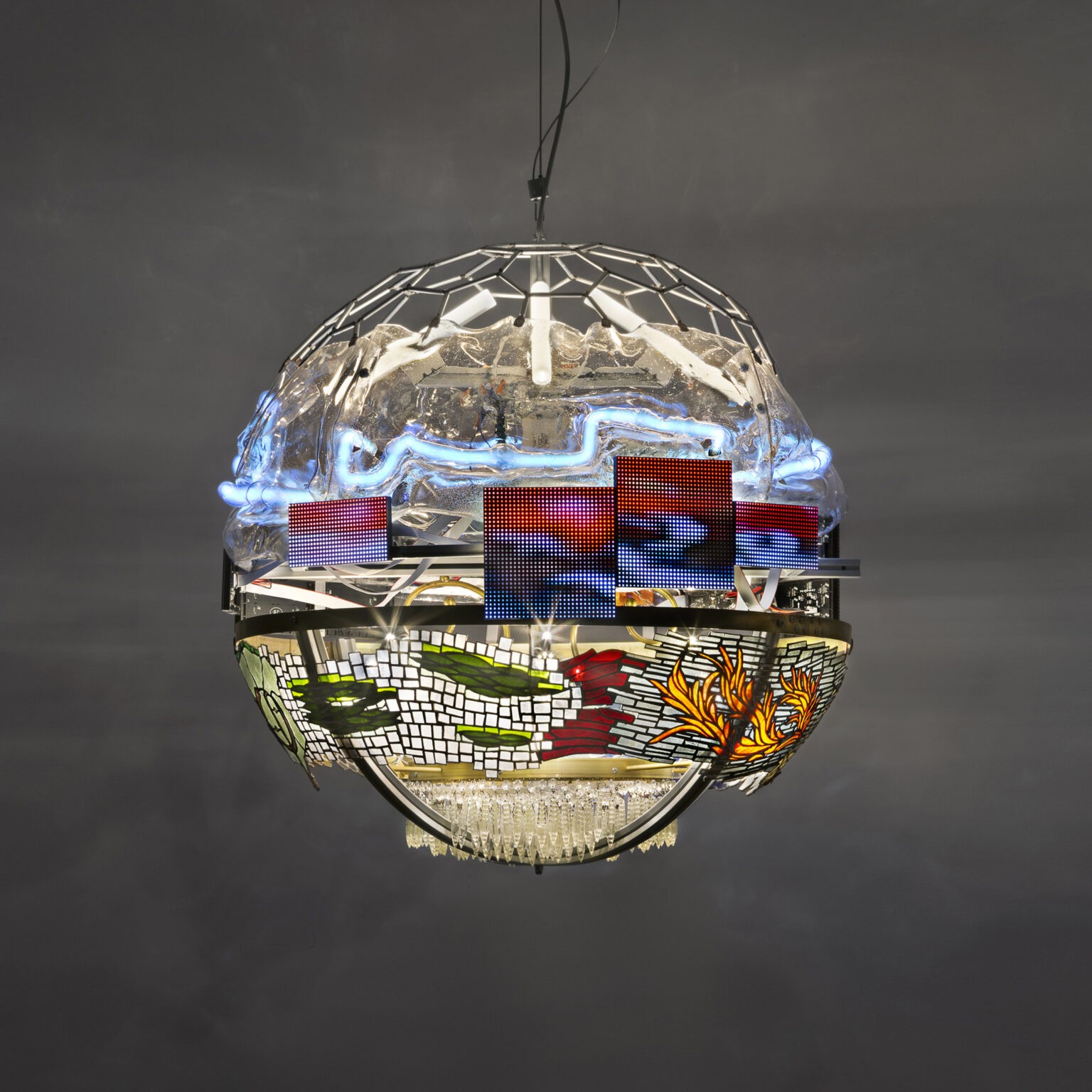
LAMBRIDIS_Elemental-Chandelier_ https://kostaslambridis.com
-Σε ενδιαφέρει λοιπόν το να “παντρέψεις” αυτά τα στοιχεία;
Κ.Λ: Δεν είναι αυτοσκοπός αλλά βάζω στη διαδικασία μου στοιχεία άλλων πολιτισμών. Βασικά πιστεύω ότι αυτά τα στοιχεία είναι ήδη παντρεμένα μέσα από την ιστορία. Θέλω να πω, οι Σουμέριοι ανακάλυψαν τον μπρούτζο πριν 5000 χρόνια και διαμόρφωσαν στην ουσία τον ανθρώπινο πολιτισμό από εκεί και ύστερα, στο σύνολό του. Αλλά όταν σήμερα δουλεύουμε με τον μπρούτζο, δεν αναγνωρίζουμε ένα στοιχείο ξένο από τον δικό μας πολιτισμό, ούτε κάποιο πάντρεμα στοιχείων. Είμαι και Έλληνας γιατί δουλεύω το μάρμαρο, είμαι και Ρωμαίος γιατί δουλεύω το τούβλο, είμαι και Κινέζος, Αμερικανός κλπ, αλλά και τίποτα από όλα αυτά τελικά.
-Τι ή ποιος θα έλεγες πως αποτελεί τη σημαντικότερή σου έμπνευση; Είναι μια σχέση μίσους ή αγάπης; Κριτικής αποτίμησης, θαυμασμού ή και των δύο; Θεωρείς πως με τη δουλειά σου εξεγείρεσαι σε κάτι/κάποιον;
Κ.Λ: Ό,τι με εμπνέει, σκέφτομαι πως ξεφεύγει από τα όρια της τέχνης καθεαυτής ή ακόμα και της υλικότητας. Σίγουρα θαυμάζω τη φύση, σίγουρα θαυμάζω τα κατάλοιπα του ανθρώπινου πολιτισμού και σίγουρα είμαι απόλυτα κριτικός στη διαδικασία της επεξεργασίας και της προσαρμογής αυτών στη δική μου δουλειά. Αλλά δεν θεωρώ πως αυτό που κάνω είναι μια εξέγερση, ή έχει κάποια τέτοια διάσταση απαραίτητα. Είμαι σκεπτικός, έχω έναν προβληματισμό στη δουλειά αλλά όχι συνειδητά, εξυπηρετώντας δηλαδή κάποια ιδεολογία ή κάποιο κείμενο, και δεν με ενδιαφέρει απαραίτητα να επικοινωνήσω κάτι τέτοιο. Αν κάποιος το βλέπει, καλώς. Εάν όχι, επίσης καλώς. Για εμένα, η δουλειά μου είναι όλα αυτά που θα δει και δεν θα δει κάποιος, ξεχωριστά και ταυτόχρονα.
-Άρα σε ενδιαφέρει ο ανήξερος θεατής; Το βλέμμα του πρωτάρη;
Κ.Λ: Ο ανήξερος με ενδιαφέρει πολύ περισσότερο από τον οποιονδήποτε γνώστη ή παντογνώστη. Η γνώση είναι φοβερά περιοριστική. Γι’ αυτό προσπαθώ, όταν μαθαίνω κάτι, όταν κάτι γίνεται κτήμα μου, όσο πιο γρήγορα μπορώ να το ξεπεράσω, να το πετάξω από πάνω μου, να μην βαθαίνω σε μια τεχνική, να μην γίνω ο καλύτερος ή να μην είναι αυτός ο σκοπός που ασχολούμαι με κάτι. Φοβάμαι να γίνω πολύ καλός μάστορας, προσπαθώ να πηγαίνω κόντρα σε αυτό. Βλέπω τι είναι αυτό που λειτουργεί για το κάθε αντικείμενο, και ως εκεί φτάνω. Γιατί είναι εύκολο να χαθείς στο σωστό και στο λάθος, και να απομακρυνθείς από την εμπειρία της διαδικασίας. Δεν έχει ζουμί για αυτό που κάνω εγώ. Δεν είμαι επαγγελματίας. Εμένα με ενδιαφέρει το υλικό και η δράση, με σεβασμό στο υλικό και με απόλυτη έλλειψη σεβασμού στην τεχνική. Θέλω αυτά που φτιάχνω να είναι καλοφτιαγμένα και κακοφτιαγμένα, όπως οι άνθρωποι. Είμαι κριτικός απέναντι στα μόνο καλοφτιαγμένα ή κακοφτιαγμένα έπιπλα design που γίνονται για να γίνονται.
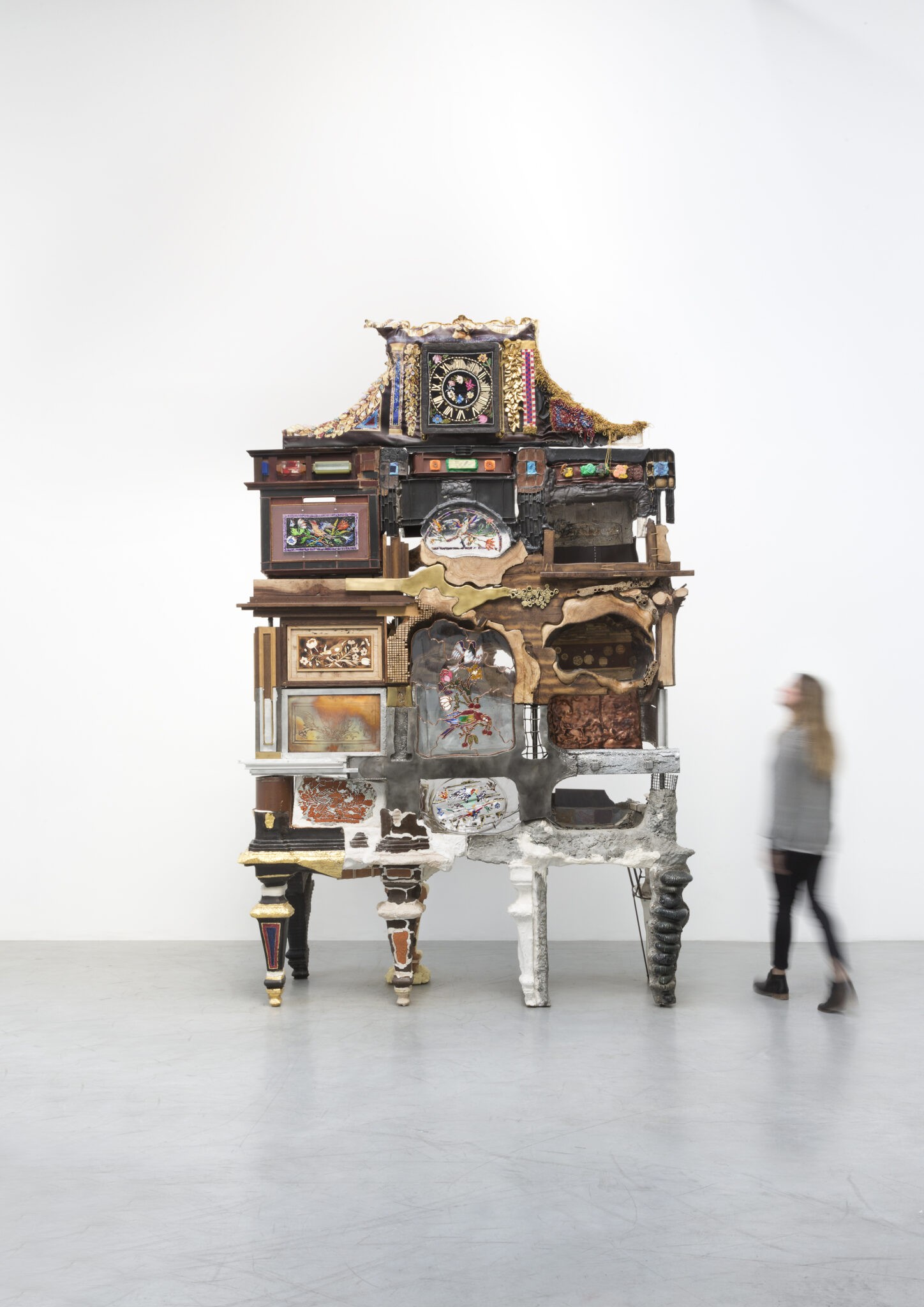
LAMBRIDIS_Elemental_Cabinet_https://kostaslambridis.com
-Ποια είναι η σχέση της Ελλάδας με το Design; Πώς βλέπεις τη σχέση αυτή στο άμεσο μέλλον, δηλαδή στην post-covid εποχή; Ξεκινάει μια γονιμότερη, ίσως, περίοδος για αυτό το είδος τέχνης; Θεωρείς ότι υπάρχουν ευκαιρίες/υποδομές/άτομα που μπορούν να κατευθύνουν κάποιον που ενδιαφέρεται, να έρθει σε επαφή με το αντικείμενο τόσο πρακτικά, δημιουργώντας, όσο και θεωρητικά, επισκεπτόμενος εκθέσεις;
Κ.Λ: Καταρχάς, δεν ξέρω τι γίνεται στην Ελλάδα, ούτε σε άλλες χώρες. Νομίζω ότι τα όρια αυτά είναι κάπως παλιακά. Νομίζω ότι από τη στιγμή που, ανεξαρτήτως τόπου, έχεις πρόσβαση στην παγκόσμια πληροφορία, με περιορισμούς προφανώς, μπορείς να έρθεις σε επαφή με το design.
-Η έμπνευση είναι ένα πράγμα ενώ η τεχνογνωσία και οι υποδομές είναι κάτι άλλο; Εσύ αναζήτησες την ευκαιρία να μάθεις αφού είχες το πάθος και την έμπνευση. Πώς θα κάνει κάποιος κάτι αντίστοιχο στην Ελλάδα;
Κ.Λ: Μακριά από την τεχνογνωσία. Αυτά έρχονται με όρους αγοράς.
-Δεν θεωρείς αλληλένδετο το design με την αγορά;
Κ.Λ: Θέλω να πιστεύω ότι δεν θα έπρεπε να είναι. Δηλαδή εγώ νιώθω πως, αυτό που κάνω, έχει και επιρροές σε σχέση με την Ελλάδα και τις σπουδές μου εδώ, και με τις σπουδές μου στην Ολλανδία, και αναφορές ταυτόχρονα σε μεγαλύτερες επιρροές, που μικρή σχέση έχουν με το ίδιο το design και με τις σπουδές μου. Ένας τρόπος -ο πιο εύκολος, αυτό που έκανα κι εγώ- είναι να πας να σπουδάσεις, αλλά πιστεύω ότι μπορείς να καταλήξεις σε κάτι ακόμα καλύτερο αν έχεις μια απόσταση από όλες αυτές τις δομές και μία ανοιχτότητα σε σχέση με τον ίδιο τον κόσμο. Αν κάνεις design για το design το ίδιο, είναι μια παγίδα. Μια παιδική ζωγραφιά είναι πάντα τέλεια, δεν υπάρχουν αναφορές, σωστά και λάθη. Άρα, για να απαντήσω, αν είσαι ένας μαθητής 17-18 στην Ελλάδα, που νιώθεις ότι σε ενδιαφέρει το design και σε ενδιαφέρει κυρίως μια καριέρα, ναι, σίγουρα υπάρχει κενό εκπαίδευσης και δομών. Αν όμως πρόκειται για ένα πηγαίο πάθος, και δεν ξέρεις πώς μπορείς να ζήσεις από αυτό, άλλα σε πρώτη φάση δεν σε νοιάζει αρκεί να μπεις στη διαδικασία να το ανακαλύψεις, τότε νομίζω ότι με κάποιον τρόπο βρίσκεις την άκρη. Παρατηρώ, ως καθηγητής στην Design Academy στην Ολλανδία, ότι το μεγαλύτερο μέρος της δουλειάς μου με τους φοιτητές είναι να τους κάνω να πετάξουν από πάνω τους τα πρέπει που τους δίδαξε μια δομή, όντας μέσα στην ίδια τη δομή και εγώ ο ίδιος. Φυσικά, αν στην πόλη που ζεις συμβαίνουν εκθέσεις, υπάρχει ανοιχτό πεδίο ενημέρωσης, έρχεσαι πιο εύκολα σε μια επαφή και ανοίγουν νέοι κόσμοι. Στην Ελλάδα, πριν 15 χρόνια, αυτό το έκαναν μια χούφτα άνθρωποι, αραιά και πού και με τους δικούς τους περιορισμούς, αλλά το έκαναν και αυτό είναι σπουδαίο. Σήμερα είναι πιο εύκολα τα πράγματα. Ακόμα υπάρχει η αίσθηση ότι κάτι γεννιέται και ξεκινάει τώρα, και αυτό δεν είναι κακό. Στην Αθήνα πάντως, υπάρχει κοινό για το design και αυτό φαίνεται με κάθε ευκαιρία.

LAMBRIDIS_Faux-Baroque_https://kostaslambridis.com
-Τι θέλεις να εδραιώσεις με τα αντικείμενα που δημιουργείς;
Κ.Λ: Δεν θέλω να φανώ ρομαντικός, στα αλήθεια όμως, το μόνο που με νοιάζει να εδραιώσω, είναι μια όμορφη ζωή για εμένα. Αυτό με ενδιαφέρει για αρχή, και για αυτό τον λόγο κάνω κάτι που αγαπώ και στο οποίο μου αρέσει να επενδύω τον χρόνο μου. Μια μέρα στο στούντιο είναι για εμένα, ανεξαρτήτως αποτελέσματος, μια ημέρα όμορφη που την έχω κερδίσει. Και σε ένα ευρύτερο πλαίσιο, με ενδιαφέρει να δημιουργήσω ένα περιβάλλον για μερικούς ανθρώπους γύρω μου, σε σχέση με αυτό που αγαπάμε από κοινού. Στο δικό μου στούντιο είμαστε 4-5 άνθρωποι που δουλεύουμε καθημερινά και περνάμε τον χρόνο μας παρέα. Επίσης, με ενδιαφέρει να είμαι κομμάτι ενός συνόλου, ενός community σε αυτή την πόλη, χώρα, κόσμο. Βέβαια, η κοινωνικοποίηση σε σχέση με τη δουλειά δεν είναι αυτοσκοπός, θέλω να έρχεται φυσικά. Αν πρέπει να δώσω μια κατεύθυνση, είναι προς τα μέσα παρά προς τα έξω.
-Άρα είναι ένας χώρος που κάποιος μπορεί να έρθει πραγματικά σε επαφή με τα υλικά και το design;
Κ.Λ: Φυσικά. Μπορεί να κάνει κάποιος την πρακτική του. Και δεν με ενδιαφέρει από πού προέρχεται, τι background έχει και τι γνώσεις πάνω στο αντικείμενο, είτε είναι η κατασκευή είτε το design. Αλλά με ενδιαφέρει να έχω ένα εργασιακό περιβάλλον, στο οποίο ζούμε τη ζωή μας σε σχέση με αυτές τις αναζητήσεις και με αυτό το κάτι που αποτελεί πάθος.
-Σε ευχαριστούμε πάρα πολύ για την κουβέντα.
Κ.Λ: Και εγώ σας ευχαριστώ.





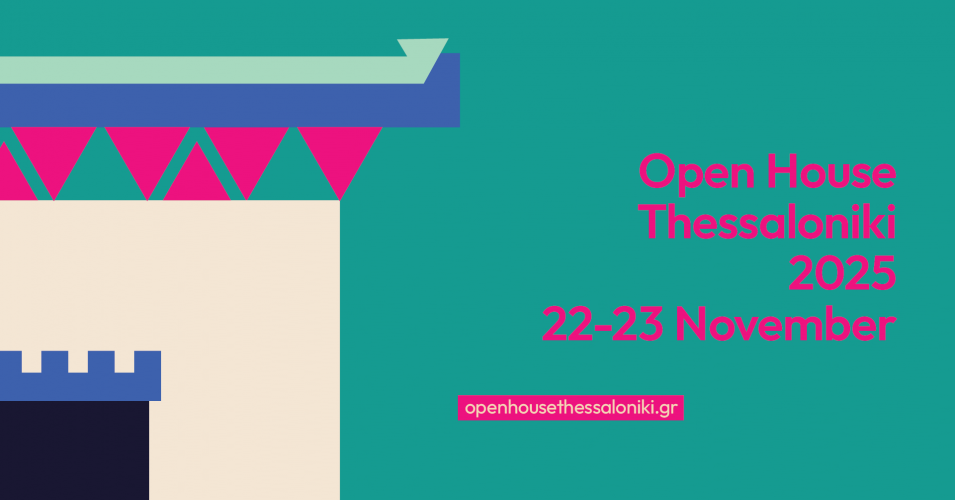
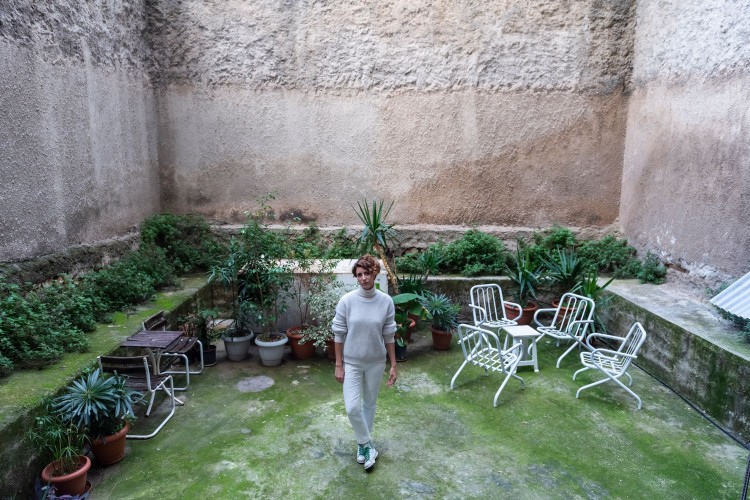
.jpg)
 (1).jpg)